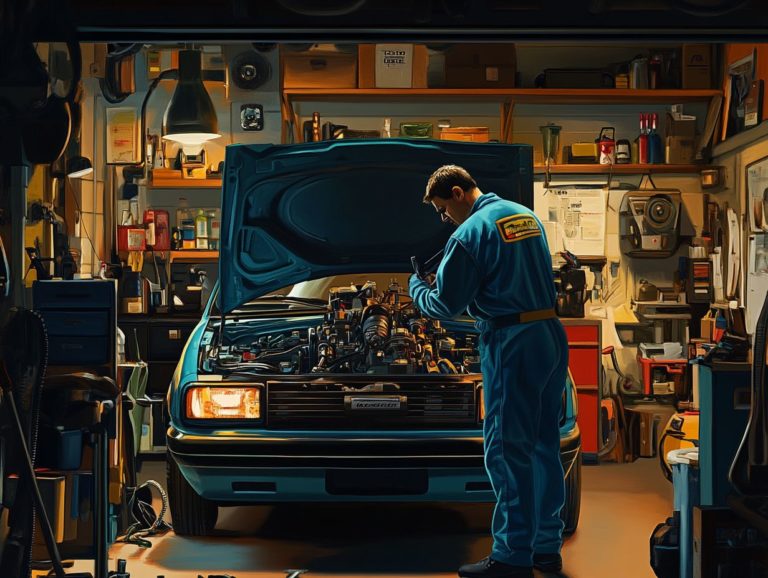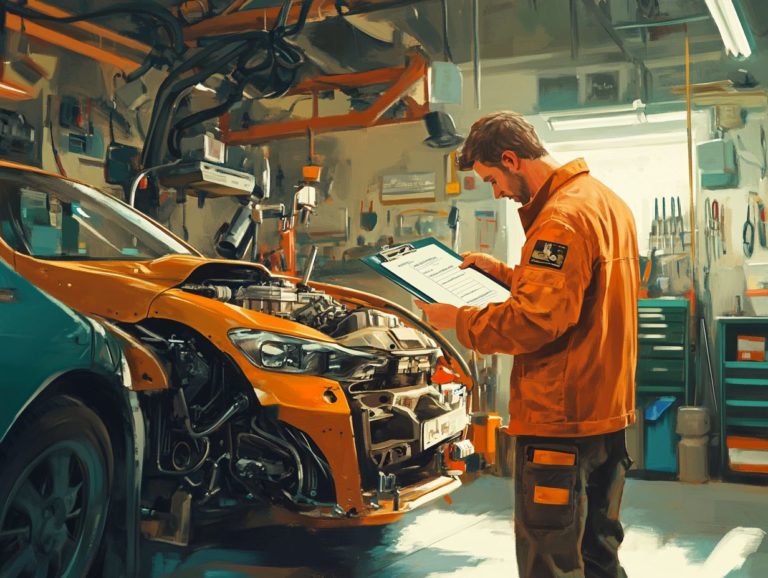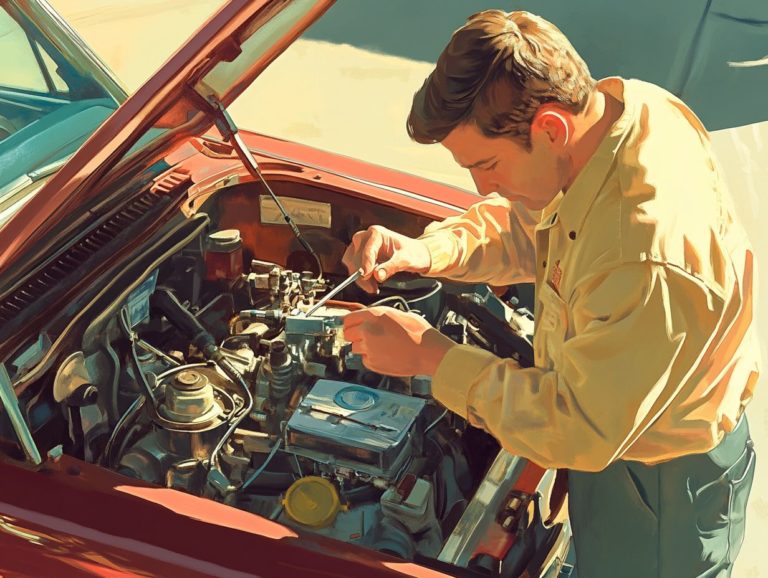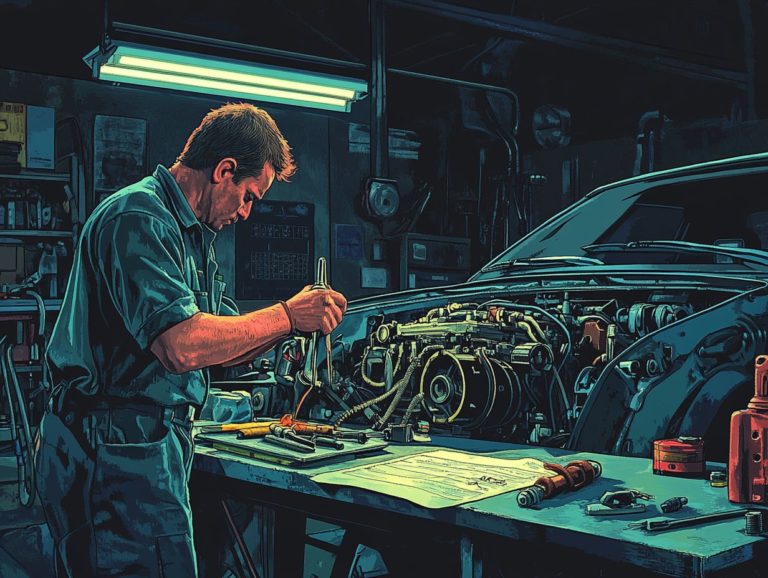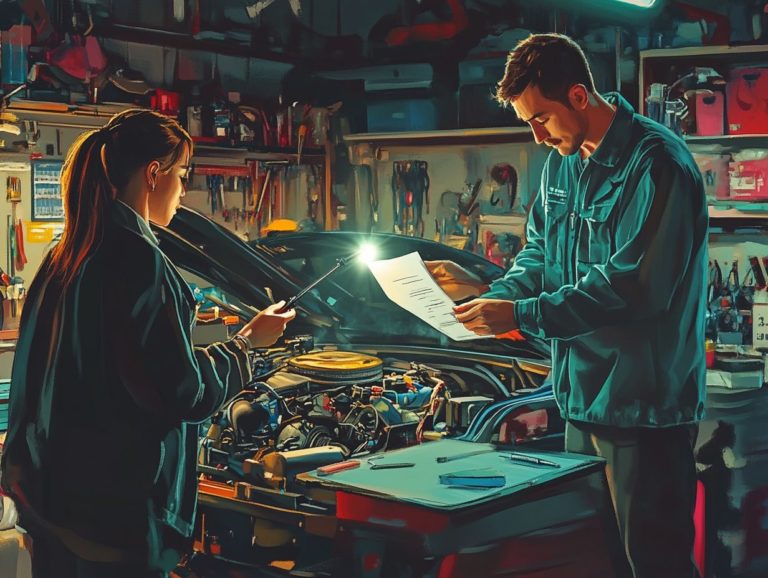Checklist for Inspecting a Car’s Safety Features
When you’re in the process of buying a car, it’s essential to ensure that its safety features meet the highest standards for your peace of mind and protection on the road.
This guide presents a comprehensive checklist for inspecting crucial safety elements in any vehicle. From seatbelts and airbags to brakes and tires, each component is integral in safeguarding you and your passengers.
Explore the key safety checks every car should possess. Let’s get started on your journey to a much safer and enjoyable ride!
Contents
- Key Takeaways:
- 1. Check the Seatbelts
- 2. Inspect the Airbags
- 3. Test the Brakes
- 4. Check the Tires
- 5. Look for Structural Damage
- 6. Shine Bright: Check Your Headlights and Taillights!
- 7. Test the Turn Signals
- 8. Ensure Proper Visibility
- 9. Inspect the Windshield Wipers
- 10. Check the Horn
- 11. Test the Emergency Brake
- 12. Inspect the Child Safety Features
- 13. Check for a Backup Camera
- 14. Test the Anti-Lock Braking System (ABS)
- 15. Check for a Tire Pressure Monitoring System (TPMS)
- What Are the Most Important Safety Features to Look for in a Car?
- Preguntas Frecuentes
- Qu debo revisar en las caracter sticas de seguridad de un autom vil?
- C mo puedo asegurarme de que los airbags est n funcionando?
- Qu debo hacer si las luces intermitentes o las luces de freno no est n funcionando?
- Hay elementos espec ficos que debo revisar en el interior?
- Qu debo buscar al inspeccionar los neum ticos?
- Necesito alg n equipo especial para inspeccionar las caracter sticas de seguridad de un autom vil?
Key Takeaways:
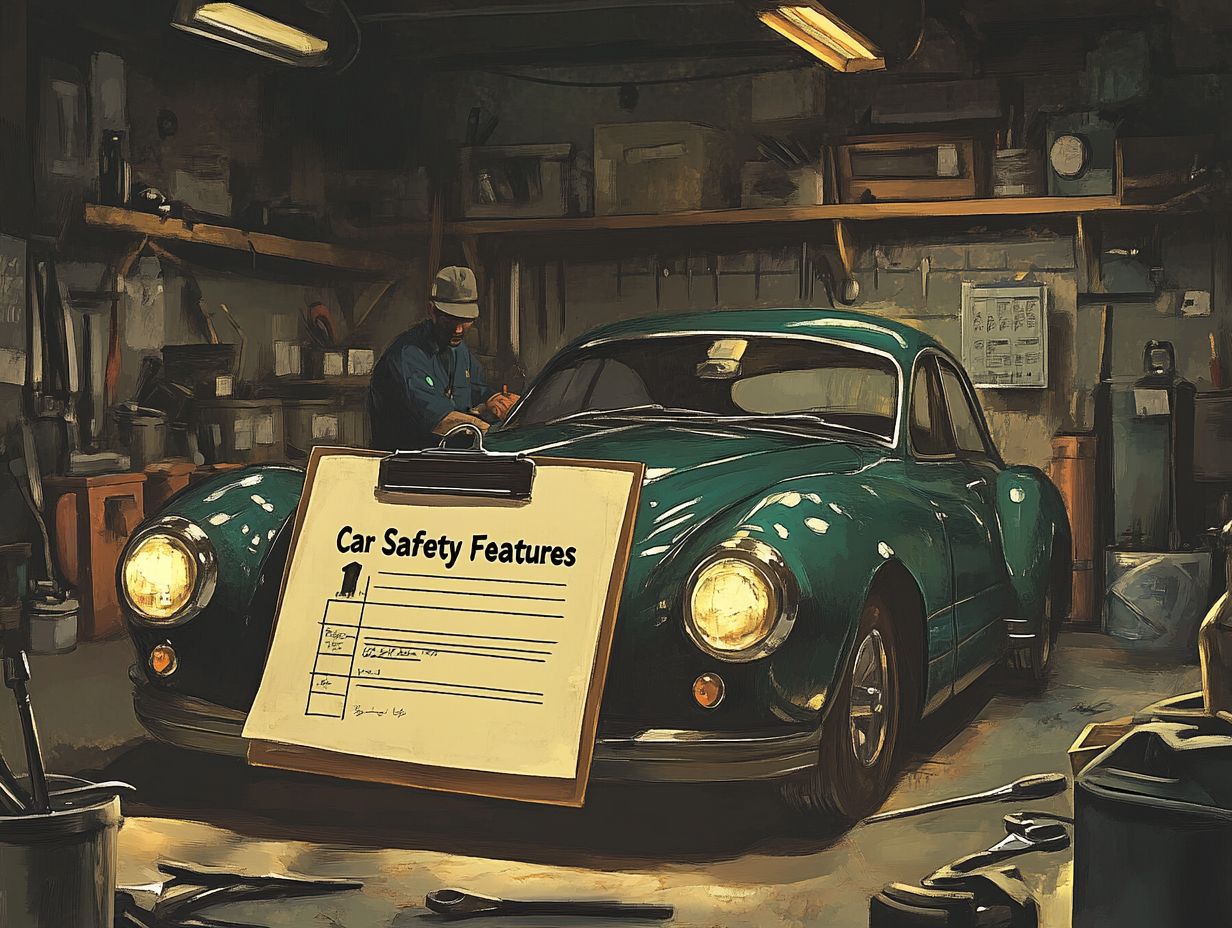
- Inspect essential safety features: seatbelts, airbags, brakes, tires, structural damage, headlights and taillights, turn signals, visibility, windshield wipers, horn, emergency brake, child safety features, backup camera, ABS (Anti-lock Braking System helps prevent the wheels from locking up during hard braking), TPMS (Tire Pressure Monitoring System).
- Regularly inspect safety features to ensure they are functioning properly.
- Look for warning signs such as unusual noises, warning lights, or malfunctions when testing safety features during a test drive.
1. Check the Seatbelts
Checking the seatbelts is a vital step in your vehicle inspections. They are instrumental in ensuring passenger safety by preventing injuries during unforeseen breakdowns or accidents.
These safety restraints act as the primary barrier that secures occupants, significantly minimizing the risk of serious injuries in the event of a collision. To maintain their effectiveness, regularly inspect seatbelts for any signs of wear or fraying.
Look for visible damage like cuts or weakened material. Ensure that the retraction mechanism operates smoothly. If the seatbelt doesn t retract completely, it could impede proper use, leading to potentially dire consequences during an accident.
Faulty seatbelts dramatically heighten vulnerability to injury. Ensure they are in optimal condition for overall vehicle safety.
2. Inspect the Airbags
Inspecting the airbags is essential during your vehicle maintenance inspections. These critical safety features deploy at crucial moments, significantly reducing the risk of injury in a collision.
During the inspection process, check the airbag warning lights on your dashboard. They should illuminate and turn off as they should, confirming the system’s functionality. A malfunctioning warning light might indicate issues within the airbag system, such as a disconnected sensor or faulty wiring.
Examine the physical condition of the airbag components, including the deployment mechanism and surrounding areas. Look for any visible signs of wear, like fraying, tears, or discoloration. These signs can hinder effective deployment during an accident, increasing the likelihood of injury and compromising your vehicle’s overall safety.
3. Test the Brakes
Testing the brakes is essential for ensuring your vehicle’s safety, as they are one of the key components responsible for stopping effectively and preventing accidents.
Start your assessment by checking the brake fluid levels to ensure they re within the recommended range; low fluid can signal a leak or wear. Inspect the brake pads and rotors for signs of wear, such as unusual grooves or reduced thickness to avoid serious damage.
By keeping your brakes well-maintained, you can save money on costly repairs while enhancing safety for everyone on the road.
4. Check the Tires
Checking your tires is a fundamental part of vehicle inspections. Their health directly influences handling, fuel efficiency, and your overall safety on the road.
Begin by assessing tire pressure, ensuring it aligns with the manufacturer s recommended levels. This simple step significantly enhances grip and helps prevent uneven wear.
Next, evaluate tread depth; insufficient tread increases the risk of skidding or hydroplaning in wet conditions. Inspect for signs of damage like cracks, bulges, or foreign objects to prevent potential blowouts.
Regular tire maintenance boosts your vehicle’s performance and creates a safer driving experience. Ignoring these crucial checks can lead to increased risks, diminished vehicle stability, and costly replacements in the future.
Start your inspection today for a safer tomorrow!
5. Look for Structural Damage
Inspecting for structural damage is an essential step in your routine vehicle checks. Overlooked issues can jeopardize safety and significantly impact your vehicle’s performance.
Begin your thorough visual inspection with a meticulous examination of the vehicle’s body and undercarriage. Look for any signs of rust or corrosion that could indicate weakening materials.
It’s crucial to assess areas like the wheel wells, chassis, and joints for dents or bends that may hint at previous collisions. Check for frame misalignment to uncover hidden structural problems that aren’t immediately apparent.
Disregarding these warning signs can lead to serious safety concerns. Ignoring them can compromise your driving experience, increase wear on vital components, and even lead to catastrophic failures while you’re on the road.
6. Shine Bright: Check Your Headlights and Taillights!
Checking your headlights and taillights is crucial for your vehicle’s safety. Functional lights enhance visibility while driving, especially in low-light conditions and bad weather.
Incorporating regular inspections of these lights into your routine maintenance is wise. Dim or burnt-out bulbs can drastically impair your ability to see and be seen on the road.
Before embarking on any journey, test your lights. Simply activate the headlights and taillights and check from a distance or enlist a friend to assist you.
Maintaining optimal brightness is essential for legal compliance. Driving with malfunctioning lights can lead to hefty fines and gravely impact safety.
Additionally, neglecting to check these critical components can result in far graver issues, including accidents that could cost lives. Make it a habit to check your vehicle regularly to stay safe on the road.
7. Test the Turn Signals
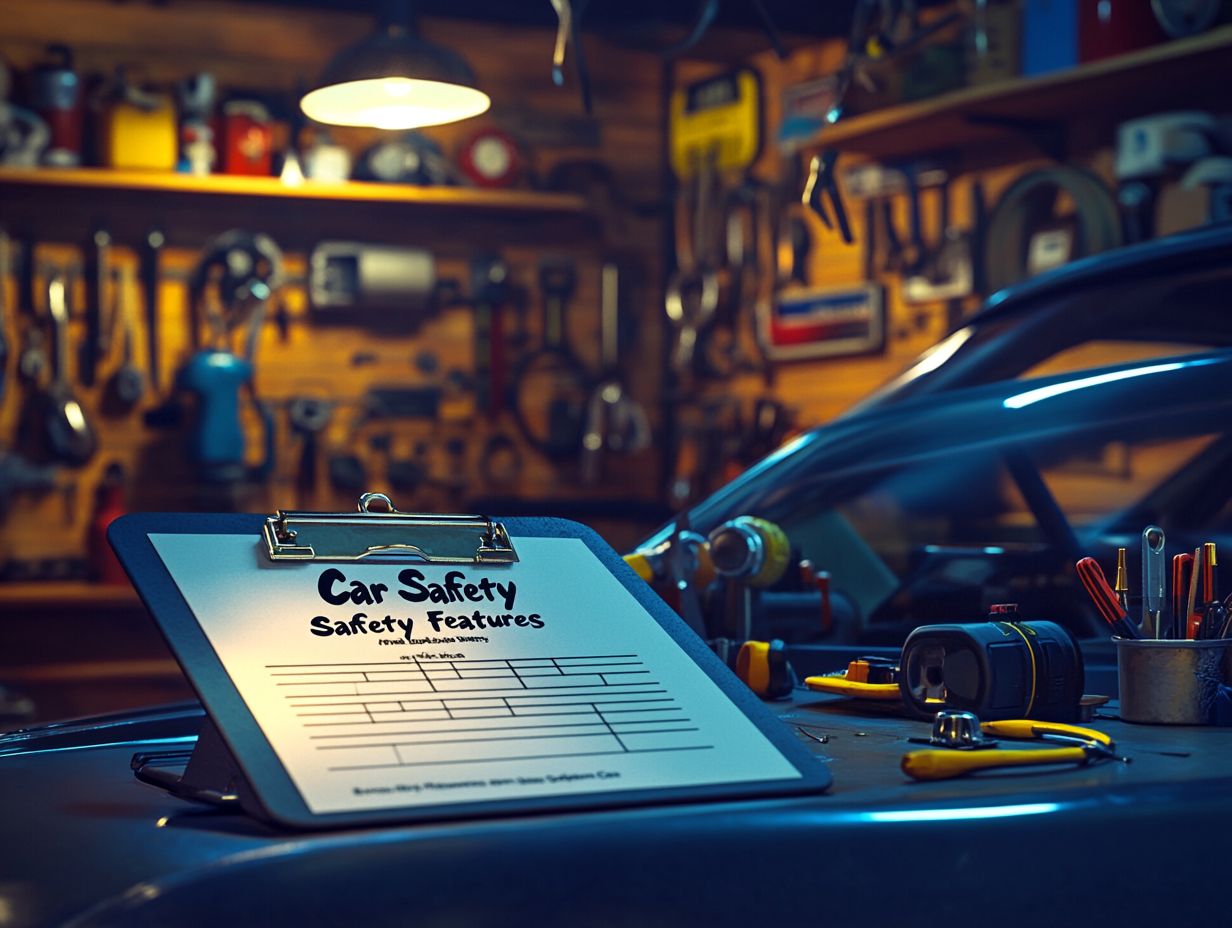
Testing the turn signals is an important aspect of vehicle inspections. Proper signaling plays a key role in safe lane changes and turning maneuvers, reducing the risk of accidents.
To ensure these lights are functioning, begin with a thorough visual check. Activate the turn indicators and carefully observe both the front and rear signals, confirming they are bright and visible from multiple angles.
Listening for the distinct clicking sound of the signaling mechanism is equally important. This indicates that the signal is engaged and functioning properly.
Maintaining your turn signals in excellent working order is not just a matter of safety but also a legal obligation. Adhering to these safety regulations helps protect everyone on the road from potential mishaps.
8. Ensure Proper Visibility
Ensuring proper visibility is fundamental for vehicle safety. Clear sightlines are vital for avoiding obstacles and providing a secure driving experience.
To conduct a thorough inspection, evaluate your mirrors, windows, and windshield condition. Make sure your mirrors are aligned and free from cracks, and ensure your windows are unobstructed.
Be vigilant about checking for obstructions, such as stickers or debris, that might hinder visibility. Damaged glass can create glare or distortions, elevating the risk of accidents.
Any limitations in visibility can lead to increased driver stress and misjudgment of distances. This further compromises your overall safety on the road.
9. Inspect the Windshield Wipers
Inspecting your windshield wipers is essential for ensuring optimal visibility during bad weather. They play a crucial role in maintaining clear sightlines and preventing accidents.
To conduct a proper inspection, closely examine the wiper blades for any signs of wear, such as cracks or fraying. These can significantly diminish their effectiveness.
Don t overlook checking the fluid levels in the washer reservoir. Clear glass is vital for safe driving, and without adequate fluid, your wipers may not perform as intended.
Regularly tending to these elements can help you avoid serious safety issues on the road. Undetected problems can impair your visibility and easily lead to accidents.
Check your wipers today and ensure you drive safely!
10. Check the Horn
Testing the horn is an essential aspect of vehicle inspections. It plays a critical role in safety by allowing you to alert others to potential dangers on the road.
Regularly checking the functionality of your horn can prevent dangerous situations. You might need to signal urgently but find the horn unresponsive.
To perform this simple test, just press the horn button and listen for a clear, audible sound. Any delay or silence could indicate a malfunction.
A faulty horn hampers your ability to communicate warnings and could lead to accidents. Other drivers may remain unaware of changing circumstances, such as an impending collision or the need to yield.
Neglecting to ensure that this crucial safety device is in proper working order could have serious consequences, not just for you but for everyone sharing the road.
11. Test the Emergency Brake
Testing the emergency brake is essential for maintaining your vehicle’s safety. It serves as a crucial backup system for halting the vehicle in critical situations.
Regular checks enhance your vehicle’s reliability and help you avoid potentially costly repairs in the future. Don’t delay; check your emergency brake now to avoid dangerous situations later!
To effectively test the emergency brake, start by ensuring the brake system is clean and free of any obstructions. Park your vehicle on a slight incline, engage the emergency brake, and gently release the regular brake to see if the vehicle remains stationary.
It s vital to perform this check periodically to catch any issues, such as weak cables or worn-out components. Neglecting this important maintenance step could lead to brake failure during emergencies, resulting in severe accidents and hefty repair bills.
12. Inspect the Child Safety Features
Inspecting child safety features is vital for ensuring the safety of young passengers. These components are meticulously designed to provide maximum protection during travel.
Regularly checking car seat anchors and locks becomes crucial. Even the smallest oversight can lead to serious consequences in the event of an accident.
Proper inspection means confirming that the anchors are securely attached to the vehicle’s frame and that the locks hold the car seat in place without showing any signs of wear or damage. Maintaining these features can significantly reduce the risk of injury.
13. Check for a Backup Camera
Don’t miss out check that backup camera for a clear view behind you! Checking for a backup camera is essential in modern vehicle safety, significantly aiding in accident prevention during reversing maneuvers by enhancing visibility.
Regularly inspect the camera lens for any dirt or obstructions that could compromise image quality. Evaluating the display screen for clarity and responsiveness is equally important.
Keep an eye out for potential issues like malfunctioning sensors or wiring problems, as these can seriously impact performance. Emphasizing regular maintenance is key to making the most of this technology and ensuring your safety on the road.
14. Test the Anti-Lock Braking System (ABS)
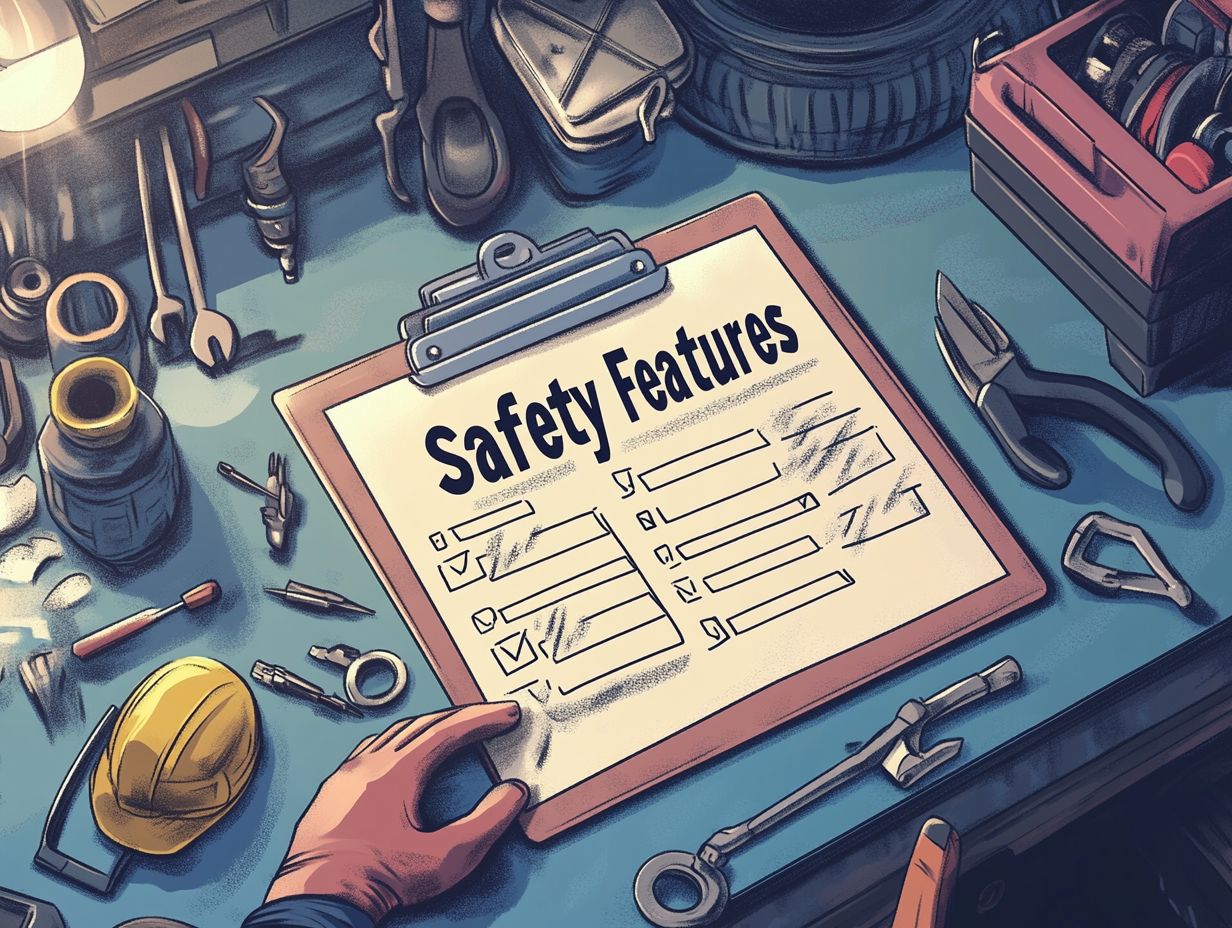
Testing the Anti-Lock Braking System (ABS), which helps prevent the wheels from locking up during sudden stops, is an essential part of vehicle safety inspections.
A thorough evaluation of the ABS requires you to check both the electronic components and the brake system to ensure they re functioning optimally. This means examining sensors, wiring, and the control module, as any malfunction can significantly reduce braking efficiency.
The importance of this testing cannot be overstated. Effective ABS operation improves handling during sudden stops and prevents wheel lock-up, which is crucial for maintaining steering control.
If you encounter issues like faulty sensors or a malfunctioning pump, you could face increased stopping distances or unpredictable vehicle behavior, both of which pose serious safety risks on the road.
15. Check for a Tire Pressure Monitoring System (TPMS)
Checking your Tire Pressure Monitoring System (TPMS) is important for keeping your car safe. This system alerts you to low tire pressure, which can compromise handling and lead to accidents. A well-functioning TPMS helps your tires last longer by ensuring they maintain optimal pressure.
To inspect this system, start by checking the dashboard indicator lights. If the warning light is illuminated, it s time for a closer look. Consider these important steps:
- Visually inspect your tires for any signs of wear or damage.
- Regularly monitor tire pressure with a gauge.
Neglecting to keep an eye on tire pressure can lead to serious dangers on the road, including reduced fuel efficiency, uneven tire wear, and, in severe cases, blowouts.
What Are the Most Important Safety Features to Look for in a Car?
Identifying the most important safety features in a vehicle is essential for ensuring optimal protection for you and your passengers. These features significantly influence overall safety while driving.
A well-equipped vehicle typically includes vital elements like airbags, which act as protective cushions during collisions, and advanced braking systems that enhance your stopping power in emergencies.
Traction control helps you stay stable on slippery roads, while visibility aids, such as rearview cameras and blind-spot monitoring, enhance your awareness of your surroundings.
Remember, regular checks matter. Routine inspections allow you to identify any potential issues, ensuring every safety element performs reliably when it matters most.
How Often Should a Car’s Safety Features Be Inspected?
Regularly inspecting your car’s safety features is crucial for ongoing vehicle safety. Many experts recommend these checks biannually, in addition to your routine maintenance inspections, and having an essential car inspection checklist can help ensure nothing is overlooked.
For vehicles that endure heavy usage like commercial vehicles or those frequently embarking on long-distance journeys it may be wise to schedule assessments even more often. These consistent checks help you spot worn-out components like brakes, tires, and lights before they malfunction.
By addressing potential issues early on, you can sidestep hefty repair bills and significantly reduce risks while on the road. Make vehicle safety a priority schedule an inspection today!
What Are the Most Common Safety Features Found in Cars Today?
The most prevalent safety features in modern cars include advanced airbags, anti-lock brakes, traction control, and backup cameras all meticulously designed to enhance your vehicle’s safety.
These elements aim not only to reduce injury during accidents but also to prevent collisions from occurring in the first place. For example, advanced airbags deploy strategically during a crash to cushion and protect you and your passengers, while anti-lock brakes prevent wheel lock-up during heavy braking, ensuring you maintain steering control.
Traction control is your ally in slippery conditions, crucial for navigating inclement weather. Backup cameras offer essential visibility when reversing, effectively minimizing blind spots.
How Can One Test a Car’s Safety Features During a Test Drive?
Testing a car’s safety features during your test drive is essential for gauging their functionality. Additionally, it’s important to know what to check in a car’s interior during inspection, as this offers valuable insights into the vehicle’s performance and reliability.
As you settle into the driver s seat, methodically assess each safety component, beginning with the brakes. Applying the brakes at various speeds will reveal how responsive and effective they are in emergencies.
Next, check that the lights are in good working order. Confirm visibility by testing the headlights, brake lights, and turn signals in all driving conditions.
Don t forget to utilize the vehicle’s visibility aids, such as rearview mirrors and camera systems, to evaluate blind spots and your overall awareness on the road.
As you conduct this thorough assessment, pay attention to any unusual sounds or behaviors; these may indicate potential issues, giving you peace of mind about the vehicle’s safety before you make your final decision.
What Are Some Red Flags When Inspecting a Car’s Safety Features?
When checking a car’s safety features, look out for warning signs that could indicate serious issues. For a thorough evaluation, refer to our checklist for inspecting a car’s steering system. Ignoring these signs can put you and others at risk.
Pay attention to warning lights for brakes or airbags. Malfunctioning parts, like worn tires or faulty headlights, can greatly endanger your safety.
Be alert for strange noises, like grinding or squealing. These could mean mechanical failures that need immediate attention.
Regular inspections help maintain your vehicle s performance and significantly lower the risk of accidents.
Preguntas Frecuentes
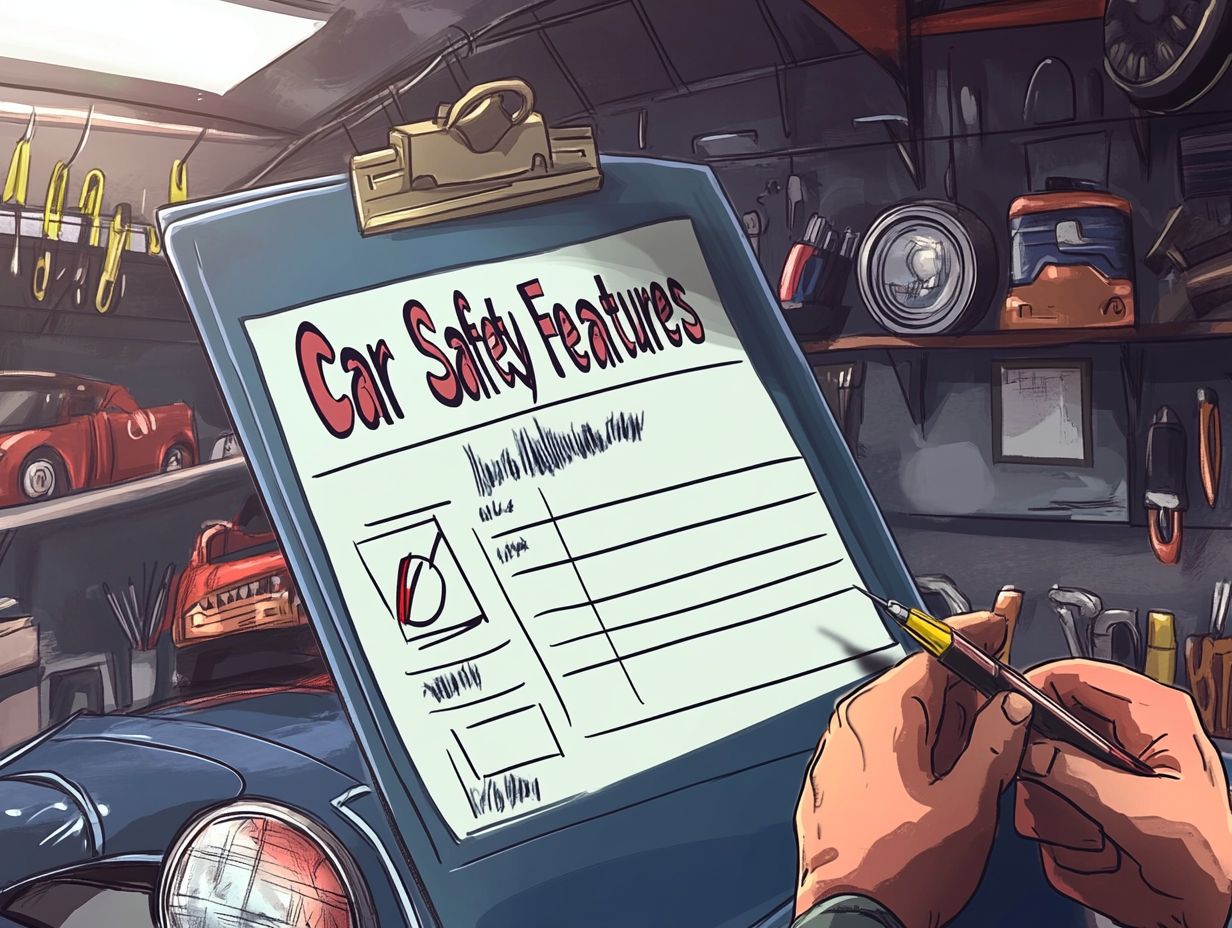
Qu debo revisar en las caracter sticas de seguridad de un autom vil?
Al inspeccionar las características de seguridad de un automóvil, verifica el funcionamiento de los cinturones de seguridad, los airbags, los faros, las luces de freno, las luces intermitentes y los espejos. Asegúrate de que los neumáticos tengan suficiente dibujo y de que los frenos estén en buen estado. También es útil consultar una inspección checklist para autos vintage para obtener pautas adicionales.
C mo puedo asegurarme de que los airbags est n funcionando?
Puedes probar los airbags encendiendo el encendido y revisando la luz de advertencia de los airbags en el tablero. Si la luz permanece encendida o no se enciende, puede haber un problema con el sistema de airbags que necesita ser inspeccionado por un profesional.
Qu debo hacer si las luces intermitentes o las luces de freno no est n funcionando?
Si las luces intermitentes o las luces de freno no funcionan, podr a deberse a un fusible quemado, una bombilla defectuosa o un problema de cableado. Es importante abordar estos problemas lo antes posible, ya que pueden afectar considerablemente la seguridad del veh culo.
Hay elementos espec ficos que debo revisar en el interior?
S, hay algunos elementos específicos que debes revisar en el interior al inspeccionar las características de seguridad de un automóvil. Estos incluyen cerraduras de puertas funcionales, ventanas eléctricas y freno de emergencia, así como asegurarte de que todas las luces de advertencia del tablero estén funcionando correctamente. Además, puedes consultar la checklist para inspeccionar un vehículo certificado para asegurarte de no pasar por alto ningún detalle importante.
Qu debo buscar al inspeccionar los neum ticos?
Al inspeccionar los neum ticos, verifica la correcta inflaci n, los signos de desgaste y la presencia de un neum tico de repuesto en el maletero. Es importante verificar la profundidad del dibujo usando una prueba con una moneda, ya que los neum ticos desgastados pueden afectar considerablemente la maniobrabilidad y las capacidades de frenado del autom vil.
Necesito alg n equipo especial para inspeccionar las caracter sticas de seguridad de un autom vil?
No necesitas ning n equipo especial para inspeccionar las caracter sticas de seguridad de un autom vil. Sin embargo, tener la ayuda de un amigo o familiar puede ser til para verificar las luces y las se ales intermitentes mientras est s dentro del autom vil. Adem s, contar con un medidor de presi n de neum ticos puede ayudarte a verificar con precisi n la presi n de los neum ticos durante tu inspecci n.

